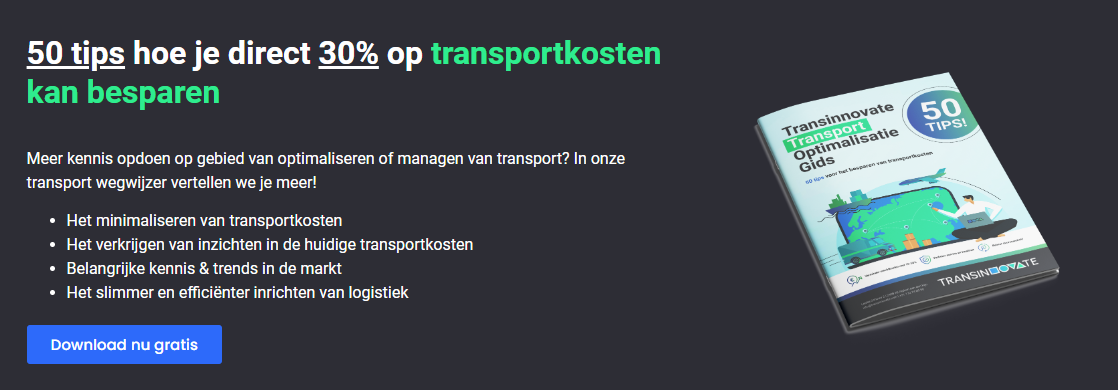Transport costs often contribute significantly to the total cost of running a business. However, in the delusion of the day, companies often have limited insight and grip on annual transport costs. As a result, there is often no clear picture of the savings potential and how savings can be realised. We would like to give you some practical tools to help you save on transport costs.

Transparent Data
Make sure you can access uniform, transparent data on your shipments at the touch of a button and then analyse them in outline and detail. For each shipment, for example, it should be clear what costs were incurred, what the base rate was, what diesel surcharge was passed on, what the modality was, whether surcharges were passed on and if so which ones, and so on. Detailed data is the basis of saving transport costs. If you do not have transparent data, perhaps it is time to look into transport management software. Besides getting a grip and insight, a TMS often has useful functionalities such as spot rate requests, which can save you transport costs as well as handling.
Here are some examples of savings opportunities when you have the right data:
- Which customers are served too often. Volume optimisation can reduce workloads within the operation in addition to reducing transport costs,
- What surcharges do you pay? For example, map which customers you regularly incur waiting costs from carriers. With better coordination and planning, these costs might be avoided,
- What modes do you use for transport? Perhaps there are opportunities to ship a bit more often by train or barge. Weigh all the pros and cons, you may be able to save transport costs here,
- Have you selected the right carrier for the shipment? Each carrier has its own strengths and weaknesses on cargo volume or region. You may already be working with carriers that could have completed shipment at lower cost,
- How many "Express" costs were incurred for rush delivery, what were the reasons and what can you do to avoid them in the future?
If you cannot easily get answers to such questions, it becomes difficult to identify and adjust savings opportunities in operations on a regular basis. This is a waste and unnecessary in this digital age.
Procurement
Of course, with good procurement, you can save transport costs at the quality you need. Again, the start is having uniform, transparent data available. Usually, companies manage to put together a shipment summary. What is often lacking is clear information on dimensions and weights of shipped shipments. During a tender or RFP, most logistics service providers calculate the impact of the potential customer's shipment profile on their network. Based on that, they can make an appropriate offer. The lack of volume/weight information will cause them to make assumptions. As a result, logistics providers will build buffers into the quotation to ensure that the right returns are achieved when business is awarded. Thus, incomplete shipment information through buffers results in higher quotations than necessary.
Besides good data, knowledge of the transport market is important when buying transport. In fact, you can often save several to tens of percent if you involve the right parties in your procurement process. Transinnovate sees countless rate tables and quotations. On this basis, we can provide you with our procurement service link from an independent position to the parties that best suit you in terms of price and service.
While shopping, another important aspect that can often save you transport costs is how you actually organise the transport. Often, companies work with one carrier per country or sometimes one carrier per destination/customer. However, each carrier has its own strengths and weaknesses at the region and volume level. Using a smart combination of groupage, LTL and FTL specialist(s) can therefore often result in significant additional savings. After all, a groupage specialist would rather not drive FTL shipments and FTL specialists would rather not drive groupage shipments, which is reflected in the quotes. During a procurement process, it is therefore important to carefully weigh all possible options and combinations. After all, by determining your ideal mix, you can save your transport costs significantly. There is specialist software that can help you do this.
Align the operation with the tender and vice versa
Make sure you optimise your shipments based on the agreements you have made. For example, if you have agreed a pallet rate with your carrier, make sure pallets are stacked as high as possible and that you use the largest pallet possible. If you have load meter agreements and find that you regularly ship half-full pallets, you can save costs by including smaller pallets. It often happens that people around the transport operation are not aware of commercial agreements on how billing is done and will not steer accordingly in the daily process. By making some adjustments in this area within the organisation, you can also save on transport costs.
Hopefully we have given you some tools to help you start saving on transport costs. Do you have transport challenges, would you like to spar with us or find out how we can support you in achieving your goals? Feel free to contact with us.




